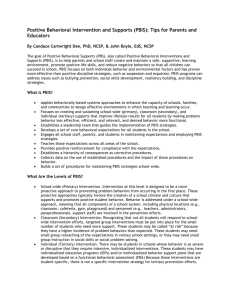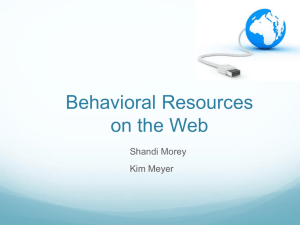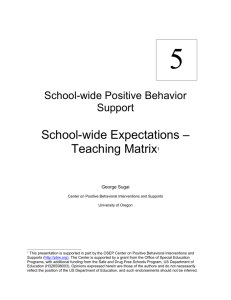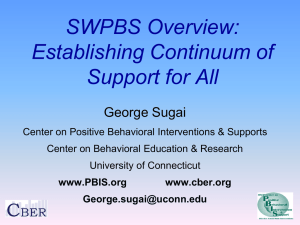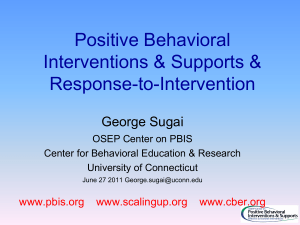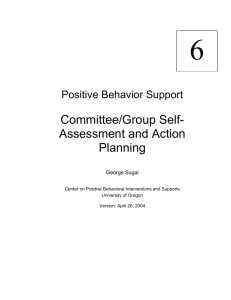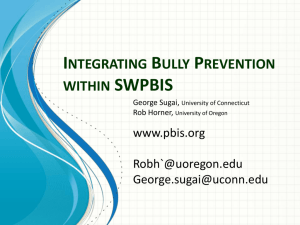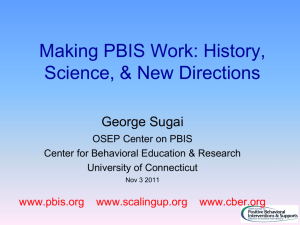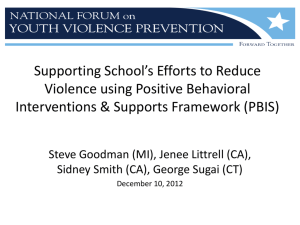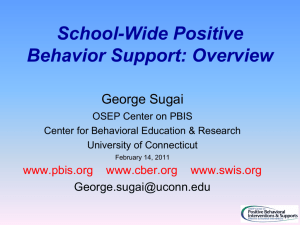George Sugai - Mental Health America
advertisement
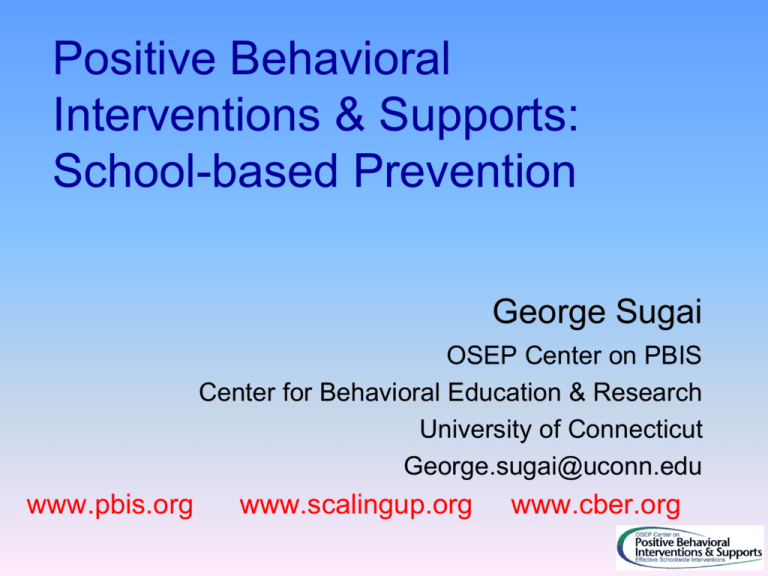
Positive Behavioral Interventions & Supports: School-based Prevention George Sugai OSEP Center on PBIS Center for Behavioral Education & Research University of Connecticut George.sugai@uconn.edu www.pbis.org www.scalingup.org www.cber.org • Surgeon General’s Report on Youth Violence (2001) • Coordinated Social Emotional & Learning (Greenberg et al., 2003) • Center for Study & Prevention of Violence (2006) • White House Conference on School Violence (2006) Positive predictable school-wide climate Multi-component, multi-year schoolfamily-community effort Safe & Respectful School Climate High rates academic & social success (prevention) Formal social skills instruction Positive adult role models Positive active supervision & reinforcement PBIS is about…. Improving classroom & school climate Integrating Decreasing academic & reactive behavior management initiatives Improving support for students w/ EBD Maximizing academic achievement PBIS (aka SWPBS) is Framework for enhancing adoption & implementation of Continuum of evidence-based interventions to achieve Academically & behaviorally important outcomes for All students Prevention Logic for All Redesign of teaching environments…not students Prevention Objectives Prevention Actions Prevent Decrease worsening & Eliminate reduce developmen triggers & t of new intensity of maintainers problem of problem existing problem behaviors behaviors behaviors Add triggers Teach, & monitor, & maintainers acknowledge prosocial of prosocial behavior behavior Biglan, 1995; Mayer, 1995; Walker et al., 1996 CONTINUUM OF SCHOOL-WIDE INSTRUCTIONAL & POSITIVE BEHAVIOR SUPPORT FEW ~5% ~15% SOME Primary Prevention: School-/ClassroomWide Systems for All Students, Staff, & Settings ALL ~80% of Students Tertiary Prevention: Specialized Individualized Systems for Students with High-Risk Behavior Secondary Prevention: Specialized Group Systems for Students with At-Risk Behavior Intensive Continuum of Support for ALL: “Molcom” Anger man. Prob Sol. Targeted Technology Ind. play Adult rel. Self-assess Attend. Universal Homework Coop play Peer interac Label behavior…not Dec 7, 2007 people Vincent, Randall, Cartledge, Tobin, & Swain-Bradway 2011; Sugai, O’Keeffe, & Fallon, 2012ab Supporting Important Culturally Equitable Academic & Social Behavior Competence OUTCOMES Supporting Culturally Valid Decision Making Supporting Culturally Knowledgeable Staff Behavior PRACTICES Supporting Culturally Relevant Evidence-based Interventions ESTABLISHING CONTINUUM of SWPBS TERTIARY PREVENTION • Function-based support • Wraparound • Person-centered planning • • SECONDARY PREVENTION • Check in/out • Targeted social skills instruction • Peer-based supports • Social skills club • PRIMARY PREVENTION • Teach SW expectations • Proactive SW discipline • Positive reinforcement • Effective instruction • Parent engagement • IMPLEMENTATION W/ FIDELITY CONTINUUM OF CONTINUOUS EVIDENCE-BASED PROGRESS INTERVENTIONS MONITORING UNIVERSAL SCREENING MTSS PBIS DATA-BASED DECISION MAKING & PROBLEM SOLVING CONTENT EXPERTISE & FLUENCY TEAM-BASED IMPLEMENTATION PRACTICE “Don’t Throw Stones!” Effective IMPLEMENTATION Effective Maximum Student Benefits Not Effective Fixsen & Blase, 2009 Not Effective Funding Visibility Political Support Policy SWPBS Implementation LEADERSHIP TEAM Blueprint (Coordination) www.pbis.org Training Coaching Evaluation Local School/District Implementation Demonstrations Behavioral Expertise Central Illinois Elem, Middle Schools Triangle Summary 03-04 1 05% Mean Proportion of Students 11% 20% 0.8 22% 0.6 84% 58% 0.4 0.2 0 Met SET (N = 23) Not Met SET (N =12) 6+ ODR 2-5 ODR 0-1 ODR North Illinois Schools (Elem, Middle) Triangle Summary 03-04 Mean Proportion of Students 1 0.8 04% 08% 14% 17% 0.6 88% 69% 0.4 0.2 0 Met SET N = 28 Not Met SET N = 11 6+ ODR 2-5 ODR 0-1 ODR 12.4 - Mean Percentage Students (2010-11 Reg Ed) (Majors Only) Students 0 or 1 Students 2 to 5 2% 5% 7% 4% 7% 12% 15% 10% 91% 83% 78% 86% 100% 90% Students 6+ 80% 70% 60% 50% 40% 30% 20% 10% 0% PreK-K N= Elementary 2979 Middle High PreK-8 889 390 254 PreK-12 Others 12.5 - Mean Percentage ODRs (2010-11 Reg Ed) (Majors Only) Students 0 or 1 Students 2 to 5 Students 6+ 100% 33% 42% 75% 81% 41% 39% 38% 39% 25% 19% 17% 21% 90% 44% 40% 80% 70% 83% 79% 60% 50% 40% 30% 20% 10% 0% PreK-K N= Elementary 2979 % of Students 9% Middle High PreK-8 889 390 254 17% 22% 14% PreK-12 Others Cultural/Context Considerations Start w/ effective, efficient, & relevant, doable PBIS Basic “Logic” PRACTICES Implementation Fidelity Prepare & support implementation Training + Coaching + Evaluation Improve “Fit” Maximum Student Outcomes RCT & Group Design PBIS Studies Bradshaw, C.P., Koth, C. W., Thornton, L. A., & Leaf, P. J. (2009). Altering school climate through school-wide Positive Behavioral Interventions and Supports: Findings from a group-randomized effectiveness trial. Prevention Science, 10(2), 100-115 • Reduced major disciplinary infractions Bradshaw, C. P., Koth, C. W., Bevans, K. B., Ialongo, N., & Leaf, P. J. (2008). The impact of school-wide Positive Behavioral Interventions and Supports (PBIS) on the organizational health of elementary schools. School Psychology Quarterly, 23(4), 462-473. • Improvement in aggressive behavior, concentration, prosocial behavior, & emotional regulation • Improvements in academic achievement • Enhanced perception of organizational health & safety • Reductions in teacher reported bullying behavior & peer rejection • Improved school climate Bradshaw, C. P., Mitchell, M. M., & Leaf, P. J. (2010). Examining the effects of School-Wide Positive Behavioral Interventions and Supports on student outcomes: Results from a randomized controlled effectiveness trial in elementary schools. Journal of Positive Behavior Interventions, 12, 133-148. Bradshaw, C. P., Reinke, W. M., Brown, L. D., Bevans, K. B., & Leaf, P. J. (2008). Implementation of school-wide Positive Behavioral Interventions and Supports (PBIS) in elementary schools: Observations from a randomized trial. Education & Treatment of Children, 31, 1-26. Bradshaw, C. P., Waasdorp, T. E., & Leaf, P. J. (2012). Effects of school-wide positive behavioral interventions and supports on child behavior problems. Pediatrics, 130(5), 1136-1145. Horner, R., Sugai, G., Smolkowski, K., Eber, L., Nakasato, J., Todd, A., & Esperanza, J., (2009). A randomized, wait-list controlled effectiveness trial assessing school-wide positive behavior support in elementary schools. Journal of Positive Behavior Interventions, 11, 133-145. Horner, R. H., Sugai, G., & Anderson, C. M. (2010). Examining the evidence base for school-wide positive behavior support. Focus on Exceptionality, 42(8), 1-14. Waasdorp, T. E., Bradshaw, C. P., & Leaf, P. J. (2012). The impact of school-wide positive behavioral interventions and supports (SWPBIS) on bullying and peer rejection: A randomized controlled effectiveness trial. Archives of Pediatrics and Adolescent Medicine, 166(2), 149-156. Common Language & Behaviors Effective Organizations Common Vision/Values Common Experience Quality Leadership

